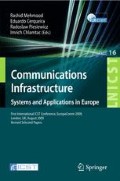Abstract
This paper considers control in road networks. Using a simple example based on the well-known Braess network [1] the paper shows that reducing delay for traffic, assuming that the traffic distribution is fixed, may increase delay when travellers change their travel choices in light of changes in control settings and hence delays. It is shown that a similar effect occurs within signal controlled networks. In this case the effect appears at first sight to be much stronger: the overall capacity of a network may be substantially reduced by utilising standard responsive signal control algorithms. In seeking to reduce delays for existing flows, these policies do not allow properly for consequent routeing changes by travellers. Control methods for signal-controlled networks that do take proper account of the reactions of users are suggested; these require further research, development, and careful real-life trials.
Access this chapter
Tax calculation will be finalised at checkout
Purchases are for personal use only
Preview
Unable to display preview. Download preview PDF.
References
Braess, D.: Uber ein Paradoxon aus der Verkehrsplanung. Unternemensforschung 12, 258–268 (1968); English translation in [7] below
Allsop, R.E.: Some possibilities for using Traffic Control to Influence Trip Distribution and Route Choice. In: Proceedings of the Sixth International Symposium on Transportation and Traffic Theory, pp. 345–374. Elsevier, New York (1974)
Dickson, T.J.: A note on traffic assignment and signal timings in a signal-controlled road network. Transportation Research B, 267–271 (1981)
Smith, M.J.: Bilevel optimisation of prices and signals in Transportation Models. In: Lawphongpanich, S., Hearn, D.W., Smith, M.J. (eds.) Mathematical and Computational Models for Congestion Charging, pp. 159–199 (2006)
Luo, Z.Q., Pang, J.S., Ralph, D.: Mathematical programs with equilibrium constraints. Cambridge University Press, Cambridge (1996)
Fletcher, R., Leyffer, S.: Nonlinear programming without a penalty function. University of Dundee Numerical Analysis report NA 171 (2000)
Braess, D., Nagurney, A., Wakolbinger, T.: On a Paradox of Traffic Planning. Transportation Science 39(4), 446–450 (2005)
Roughgarden, T.: Selfish routing and the price of anarchy. MIT Press, Cambridge (2005)
Valiant, G., Roughgarden, T.: Braess’s Paradox in Large Random Graphs. In: Proceedings of the 7th ACM Conference on Electronic Commerce (2000)
Smith, M.J.: A local traffic control policy which automatically maximises the overall travel capacity of an urban road network. In: Proceedings of the International Conference on Urban Traffic Control Systems, Berkeley, California (August 1979); Traffic Engineering and Control 21, 298–302 (1980)
Smith, M.J.: Traffic control and route choice; a simple example. Transportation Research 13B, 289–294 (1979)
Smith, M.J.: The existence, uniqueness and stability of traffic equilibria. Transportation Research 13B, 295–304 (1979)
Webster, F.V.: Traffic signal settings, Department of Transport, Road Research Technical Paper No. 39, HMSO, London (1958)
Robertson, D.I.: TRANSYT: a traffic network study tool. RRL Lab. report LR253, Road Research Laboratory, Crowthorne, UK (1969)
Hunt, P.B., Robertson, D.I., Bretherton, R.D., Winton, R.I.: SCOOT - A Traffic Responsive Method of Coordinating Signals. Transport and Road Research Laboratory Report 1014, Transport and Road Research Laboratory, Crowthorne, UK (1981)
Wardrop, J.G.: Some theoretical aspects of road traffic research. In: Proceedings of the Institute of Civil Engineers, Part II, vol. 1, pp. 325–378 (1952)
Cohen, J.E., Kelly, F.P.: A paradox of congestion in a queueing network. J. Appl. Prob. 27, 730–734 (1990)
Smith, M.J., van Vuren, T.: Traffic equilibrium with responsive traffic control. Transportation Science 27, 118–132 (1993)
Author information
Authors and Affiliations
Editor information
Editors and Affiliations
Rights and permissions
Copyright information
© 2009 ICST Institute for Computer Science, Social Informatics and Telecommunications Engineering
About this paper
Cite this paper
Smith, M. (2009). Intelligent Control of Urban Road Networks: Algorithms, Systems and Communications. In: Mehmood, R., Cerqueira, E., Piesiewicz, R., Chlamtac, I. (eds) Communications Infrastructure. Systems and Applications in Europe. EuropeComm 2009. Lecture Notes of the Institute for Computer Sciences, Social Informatics and Telecommunications Engineering, vol 16. Springer, Berlin, Heidelberg. https://doi.org/10.1007/978-3-642-11284-3_13
Download citation
DOI: https://doi.org/10.1007/978-3-642-11284-3_13
Publisher Name: Springer, Berlin, Heidelberg
Print ISBN: 978-3-642-11283-6
Online ISBN: 978-3-642-11284-3
eBook Packages: Computer ScienceComputer Science (R0)

